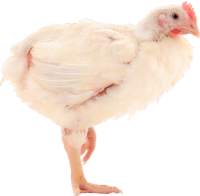Stable & continuous coccidiosis control in poultry is key to avoiding the damaging effects to productivity
Saves up to 6% feed and 6% water1
Reduces antibiotic usage by up to 5x2,3
Reduces the rate of secondary diseases such as necrotic enteritis4
Results in drier litter and less associated diseases (e.g. breast blister, pododermatitis and hock burn)5-7
Elanco poultry products to manage coccidiosis
(Log in required to view)
Using Maxiban™ in combination with Monteban™ provides continuous and stable coccidiosis control:
- Lower labour requirements
- Stable coccidial population control
- FCR improvements of 5.468
- Stable intestinal integrity (I2) scores9
- Over 20 years of successful coccidiosis control for
poultry producers worldwide
- Another layer of protection
Narasin:
the ionophore of choice
Narasin is significantly more effective at reducing intestinal lesions than monensin, when administered at the same dose rate6
When potentiated with nicarbazin, narasin is more potent than monensin when included at equal rates10
Narasin = 71%
of original inclusion rate
Monensin = 42%
of original inclusion rate
Unlike other ionophores, narasin has a positive effect on feed intake, growth and FCR12-14
Maxiban has been shown to outperform a similar monensin/nicarbazin programme11
 more feed efficacy
more feed efficacy more growth
more growth more breast meat
more breast meat
Uniquely among the ionophores, Narasin has a significant impact on reducing gizzard erosion15
Achieve stable coccidiosis control by using Maxiban and Monteban continuously

Low anorexic effect,
bird maintain feeds
intake12
Allows bird immunity to
develop, while still effectively
controlling disease
Using Maxiban for at least another 7 days past the peak coccidial challenge
improved FCR by up to 0.23 pts per day of extension1
➡ outperforming all other ionophore programmes
Maxiban and Monteban have been helping poultry producers
achieve effective coccidiosis control for over 20 years.
But what about other coccidiosis solutions?
(Log in required to view)
- Williams, R. 1999. “A compartmentalized model for the estimation of the cost of coccidiosis to the World’s chicken production industry”. Int Journ.for Parasitoloty. 29(8):1209-1229
- Saggiorato et al., - Can we predict early performance of a broiler flock? Experience from Clostridium Firstest – XIIIth European Poultry Conference – Tours, 2010
- Salois M, Heskett E. (2017). Raised without antibiotics can lead to more use of medically important antibiotics, unpublished.
- Lanckriet A, Timbermont L, De Gussem M, Marien M, Vancraeynest D, Haesebrouck F, Ducatelle R, Van Immerseel F. The effect of commonly used anticoccidials and antibiotics in a subclinical necrotic enteritis model. Avian Pathol. 2010 Feb;39(1):63-8
- Clave H et al Sci Tech Avicoles 2004
- Ruff, MD, et al. (1980) Anticoccidial activity of Narasin in broiler chickens reared in floor pens. Poultry Sci; 59:2008-2013
- HTSi Data EMEA region 2010-2016
- For a company producing 100 million birds per year on a full Maxiban™ and Monteban™ programme compared to a Monensin/Nicarbazin and Salinomycin programme for 3 crops of the year. Elanco data on file REF-22071
- Elanco, 2018: HTSi UK Data 2015-2018 / Performance data 2014-2018 – Tom Hepburn – EKS Specialist
- Elanco data on file, Study GMONNIC_SUM_2021_001 2021
- Elanco Animal Health Study ELA1900304 2019. Data on file
- Weppelman, R. et al. Comparison of Anticoccidial Ecacy, Resistance and Tolerance of Narasin, Monensin and Lasalocid in Chicken Battery Trials. 1977. Poultry Sci; 56.5:1550-59 5.
- Metzler,M. et al. “Effects of Monensin Feeding and Withdrawal Time on Growth and Carcass Composition in Broiler Chickens.” 1987. Poultry Sci; 66.9:1451-58 6.
- Harms, R. and Buresh R. “Influence of Salinomycin on the Performance of Broiler Chicks.”1987. Poultry Sci; 66: 51
- Kaldhusdal, M. et al 2012 “Non-soluble fibres and narasin reduce spontaneous gizzard erosion and ulceration in broiler chickens” Avian Pathology 41(2), 227-234